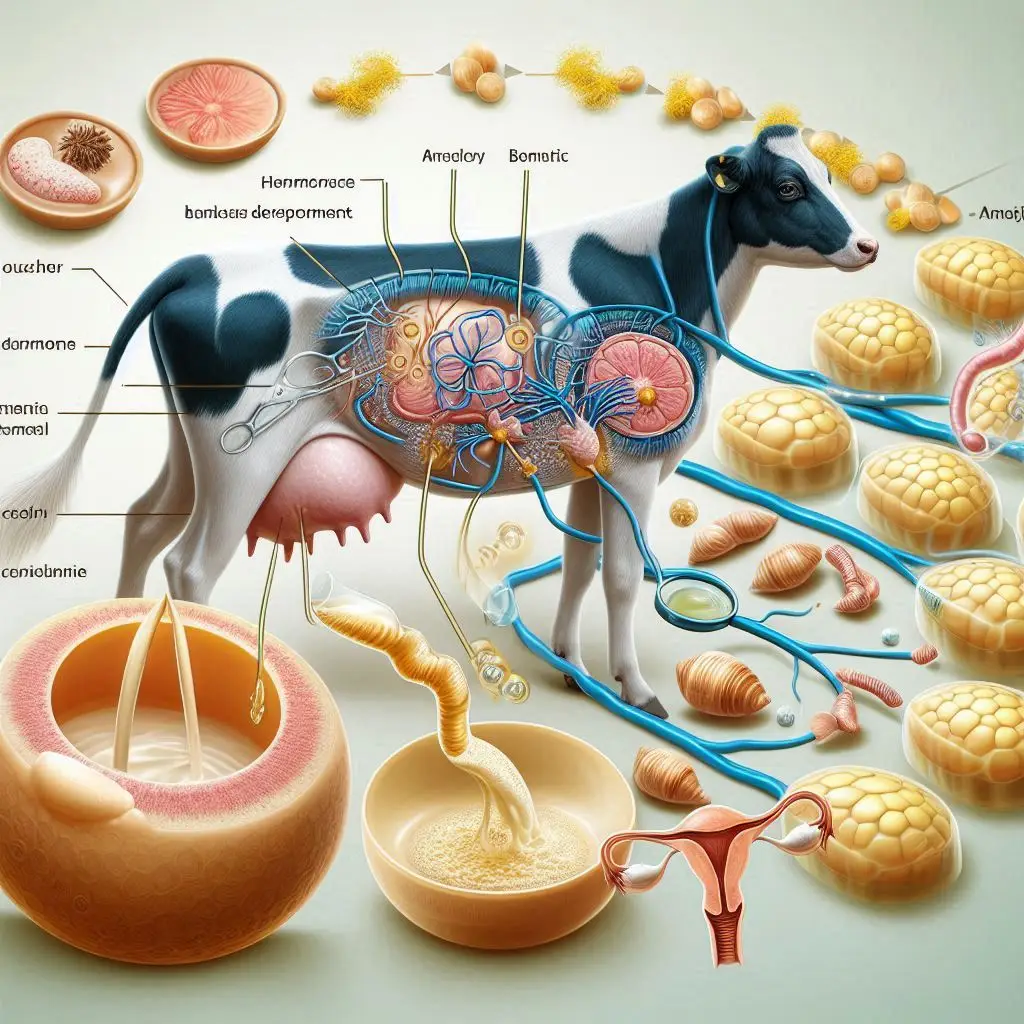Milk Formation in Dairy Animals

Physiology of Milk Formation in Dairy Animals
The physiology of milk formation in dairy animals, particularly in cows, involves a complex interplay of anatomical structures, hormonal regulation, and metabolic processes. Understanding these mechanisms is crucial for optimizing milk production and ensuring the health of dairy animals.
Anatomy of the Mammary Gland
The mammary gland is the primary organ responsible for milk production and consists of several key components:
Alveoli
The functional units where milk is synthesized. Each alveolus is lined with mammary epithelial cells (MECs) that secrete milk components such as lactose, proteins, and fats. The structure of the alveoli allows for efficient nutrient absorption and milk synthesis.
Duct System
Milk produced in the alveoli drains into larger ducts that lead to the gland cistern, a storage area for milk before it is ejected through the teat. This system ensures that milk can be effectively transported during milking.
Cisterns
Specialized structures that store significant quantities of milk; they are crucial for managing milk flow during milking. The gland cistern and teat cistern work together to regulate how much milk is available for extraction.
Suspensory Ligaments
These support the weight of the udder, which can exceed 25 kg, especially before milking. Proper support is essential for maintaining udder health and preventing injury.
Hormonal Regulation of Milk Production
Milk formation is regulated by a variety of hormones that control both the synthesis and secretion processes:
Prolactin
This hormone plays a central role in stimulating milk synthesis. It promotes the development of alveoli during pregnancy and increases lactation when suckling or milking occurs. Prolactin levels rise significantly during late pregnancy and early lactation.
Growth Hormone (GH)
GH enhances overall milk yield by promoting nutrient partitioning towards the mammary gland. Its effects are mediated by insulin-like growth factor 1 (IGF-1), which also plays a role in cellular growth and development.
Oxytocin
Released during suckling or milking, oxytocin stimulates myoepithelial cells surrounding the alveoli to contract, facilitating milk ejection. This hormone is crucial for ensuring that milk can be efficiently removed from the udder.
Metabolic Processes in Milk Formation
The metabolic pathways involved in milk production are critical for understanding how dairy animals convert nutrients into milk:
Lactose Synthesis
Approximately 85% of glucose turnover during lactation is directed towards lactose synthesis, which is a major determinant of milk volume. Glucose availability can be limited early in lactation due to competing demands from other body systems. For more information on lactose synthesis, you can visit Respona.
Nutrient Utilization
The mammary gland requires a continuous supply of nutrients, including glucose and fatty acids, to maintain high levels of milk production. Blood flow to the mammary gland is essential; about 500 liters of blood must circulate through the udder to produce just one liter of milk.
Stages of Lactation
The lactation cycle in cows consists of several distinct phases:
Colostrum Production
Immediately after calving, cows produce colostrum, which is rich in antibodies and essential nutrients for calves. This initial milk is crucial for calf health and immunity.
Peak Lactation
Milk production typically peaks 3 to 6 weeks post-partum. This peak is influenced by factors such as body condition at calving and nutritional management. Proper management during this phase can significantly impact overall production.
Decline Phase
After reaching peak production, there is a gradual decline in milk yield over approximately 305 days before entering a dry period where no milking occurs, allowing the udder to rest and prepare for the next lactation cycle.
Conclusion
The physiology of milk formation in dairy animals involves intricate anatomical structures supported by hormonal and metabolic processes. Understanding these mechanisms not only aids in improving dairy production but also ensures animal welfare through better management practices. Continuous research into these areas can help optimize lactation strategies and enhance overall dairy farm productivity. For further reading on dairy management practices, you can explore articles from Moz and Tempesta Media.
More from Veterinary Physiology:
https://wiseias.com/temperature-stress-animal-heart-health/
https://wiseias.com/understanding-factors-that-regulate-glomerular-filtration-rate-gfr-in-animals/





Responses